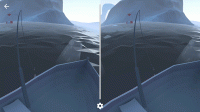Anna Leach – Assignment 1: My VR Experience
by Anna Leach
- September 4
- in
Coming into lab on Wednesday, like others in the class, I had no hands-on VR experience. " Moving from device to device, the reality of the medium's "wild west" nature became so much more clear to me; even with some sizeable similarities, there was a lot of variation in the apps/programs, the physical and digital design, the use of the senses, the target market(s) etc., too. All of those things affected how the stories were executed and then how they were felt.
The first device I used was the HoloLens. In terms of physicality, my group and I all found the device to be fairly comfortable (though as a person with very little/a flatter nose bridge, there was some shining up into my vision if I looked in a downward direction or too far left or right). I loved the dynamic nature of the dessert valley lesson, from the current-day people walking around to the bits of animation thrown in to represent past events. This approach really seemed to pull people in. Even though you could see the classroom, almost everyone I saw was fully focused on the content inside the viewer. The fact it pulled attention so well seems to be a positive sign. There were some little kinks, (for example, the gestures sometimes didn't work - maybe because we were switching people of different heights so often) but this was one I can really see having a lot of practical, consumer application in the near future.
Having used Google Cardboard viewers before, I chose to take a more observational role at this station. Even though, comparatively, the cardboards are more "low-tech," people still seemed to be pretty immersed in the content and many different stories. I wonder if this is because there's a larger body of people/companies creating content that works with the cardboard, so there's a lot of diversity in story ideas. I wonder, as the other devices are around longer and possibly become more available, how the marketplace will expand and push the hardware. Additionally, the high range of movement (even if you have to hold the device) was aided by lack of cords, and overall, the operations were intuitive and easy to grasp. Although we weren't breaking any down, their easy portability is also highly attractive.
The Oculus dev kit 2 was the only device where I saw people struggling with motion sickness. The limitation of using the letter keys and the way you had to be perfectly aligned when beginning (or the movements felt clunky or awkward) seemed to leave the user with a lot more to think about at the start, especially if you have little experience with gaming. That said, the story was a fascinating concept that seems to push how we talk about and process traumatic events for ourselves and others and an amazing illustration of how a student can execute a very high-quality product.
I tried using the Samsung GearVR, however, unfortunately, it kept asking for login credentials, and so I and a few others moved on for the sake of time. Next, I moved on to the HTC Vive. By far the HTC Vive was getting the most audible reactions as the most complex and most immersive of the technology in the room. She said a lot of her reaction had to do with the way intentional sound design added another depth to feeling "actually there." When I was using the HTC Vive, even though I was working on VR painting instead of in a narrative, sound did a lot to help me loose track of my surroundings and pull me into my work/connect me to the experience I was having in VR . In terms of software design, I loved how the HTC Vibe experiments with the interplay between real-life and virtual physical movements. Sometimes, the balance between direct correlations (for example, ducking in real-life and thus ducking in VR) and modified ones (for example, walking "through" objects in VR, which would be impossible in real-life) kept the process easy to understand but still exciting. The most external reminder of being in simmulation, though, was the way the cords were organized. I and others a few times seemed to get a little twisted or trip over different wires.
Because I spent some much time in the HTC Vive, I was unable to experience the sitting Occulus. However, I saw most people had a very positive reaction, especially to programs like the U2 app, which played the want to experience certain things "with" other people without actually being there. The setup, although it had a couple of pieces, seemed to be fairly easy to navigate.
As Charles noticed, this was one of the only classes I've had recently where people seemed to linger, to want to stay after class and keep playing or discussing. I think this tells a lot about the new medium, that it holds attention not just by physically giving your eyes something new but also conceptually. There's a lot of power in that. However, I wonder if there will be a hard break in VR and mixed; the supernatural experiences vs. the one's that help or enhance everyday life.

COMMENTS